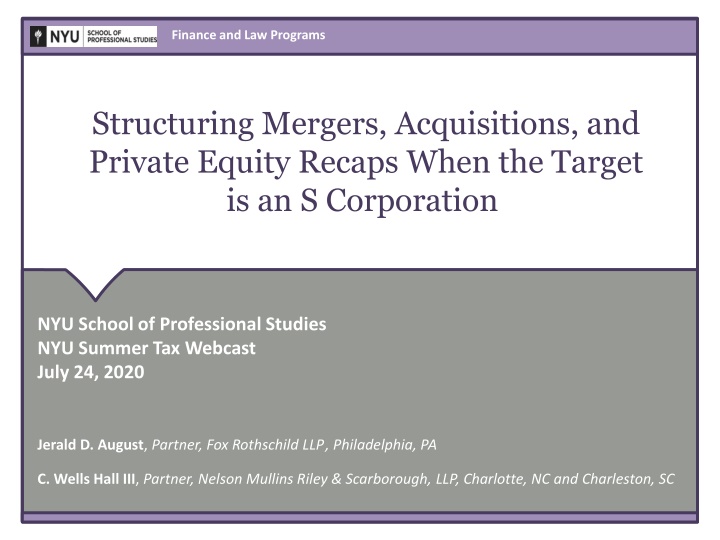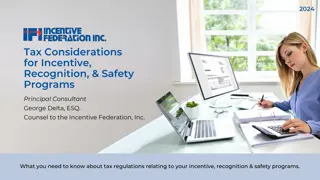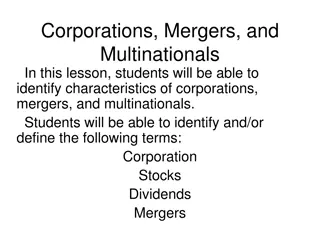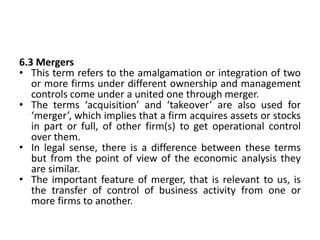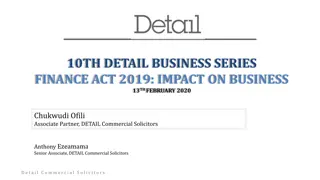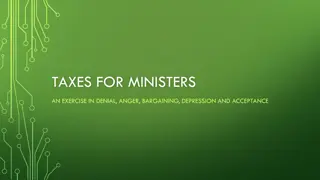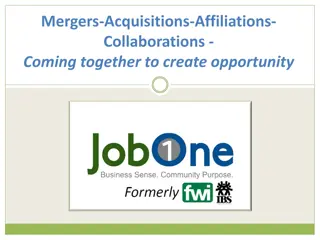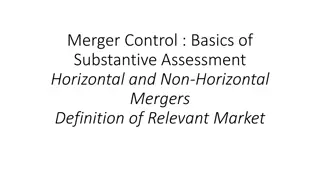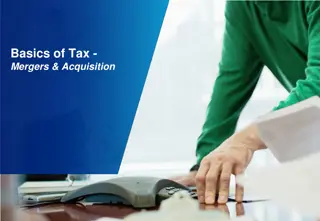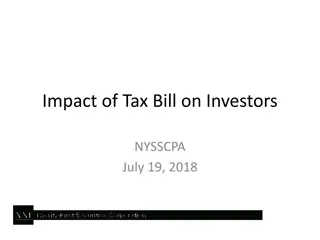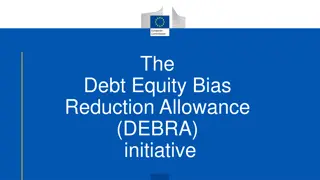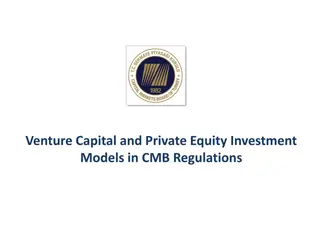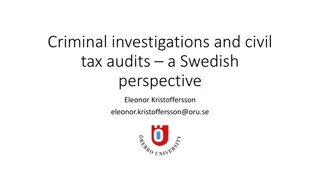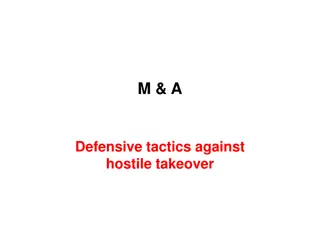Structuring Mergers, Acquisitions, and Private Equity Recaps: Tax Implications for S Corporations
Explore the tax implications for S Corporations in mergers, acquisitions, and private equity recaps, focusing on changes brought by the Tax Cuts and Jobs Act of 2017. Topics include income tax rate changes, dividends received deduction, and the Corporate AMT.
Download Presentation

Please find below an Image/Link to download the presentation.
The content on the website is provided AS IS for your information and personal use only. It may not be sold, licensed, or shared on other websites without obtaining consent from the author.If you encounter any issues during the download, it is possible that the publisher has removed the file from their server.
You are allowed to download the files provided on this website for personal or commercial use, subject to the condition that they are used lawfully. All files are the property of their respective owners.
The content on the website is provided AS IS for your information and personal use only. It may not be sold, licensed, or shared on other websites without obtaining consent from the author.
E N D
Presentation Transcript
Finance and Law Programs Structuring Mergers, Acquisitions, and Private Equity Recaps When the Target is an S Corporation NYU School of Professional Studies NYU Summer Tax Webcast July 24, 2020 Jerald D. August, Partner, Fox Rothschild LLP, Philadelphia, PA C. Wells Hall III, Partner, Nelson Mullins Riley & Scarborough, LLP, Charlotte, NC and Charleston, SC
Structuring Mergers, Acquisitions, and Private Equity Recaps When the Target is an S Corporation Business Tax Provisions of the TCJA of 2017 Finance and Law Programs 2
Structuring Mergers, Acquisitions, and Private Equity Structuring Mergers, Acquisitions, and Private Equity Recaps When the Target is an S Corporations Recaps When the Target is an S Corporations TCJA Income Tax Rate Changes Income Tax Rate Changes TCJA Before the Tax Cuts and Jobs Act (the TCJA ), corporations were subject to graduated rates of income tax that resulted in a 35% corporate rate for taxable income over $10M, with a phase out of the lower rate for taxable income over $100,000. Certain personal service corporations were subject to a maximum rate of tax at 35%. The maximum rate of a corporation s net capital gain was also 35%. The new law reduces the corporate income tax to 21% and repeals the maximum corporate tax rate on net capital gain as obsolete. Finance and Law Programs 3
Structuring Mergers, Acquisitions, and Private Equity Structuring Mergers, Acquisitions, and Private Equity Recaps When the Target is an S Corporation Recaps When the Target is an S Corporation - - Dividends Received Deduction Received Deduction Dividends The 2017 Tax Act reduces the dividends received deduction (the DRD, in general, applicable to corporate shareholders receiving a dividend from certain domestic corporations) for the 70 percent and 80 percent brackets, to 50 percent and 65 percent, respectively, for taxable years beginning after December 31, 2017. The 100 percent DRD remains intact for dividends from affiliated group members. Section 245 provides for a 100% DRD from 10% owned foreign corporations and section 965 provides for a transition tax on foreign earnings reduces the tax cost of repatriating offshore earnings. Finance and Law Programs 4
Structuring Mergers, Acquisitions, and Private Equity Recaps Structuring Mergers, Acquisitions, and Private Equity Recaps When the Target is an S Corporation When the Target is an S Corporation - - The Corporate AMT The Corporate AMT Prior to the TCJA, corporations were subject to the C-AMT to the extent that the tentative minimum tax exceeds its regular tax. The tentative minimum tax is computed at the rate of 20% on the AMTI in excess of an exemption amount AMTI is the taxpayer s taxable income increased by certain preference items. A major item included in the corporation s AMT base is the adjusted current earning ( ACE ) adjustment. The ACE adjustment is equal to 75% of the amount by which adjusted current earnings of a corporation exceed AMTI. The NOL carryover of a corporation cannot reduce the AMT base by more than 90% of the NOL. Nonrefundable business credits allowed for regular tax purposes are not allowable for C-AMT. Where a corporation is subject to the C-AMT, the amount of C-AMT is a credit for use in any subsequent tax year where the taxpayer s regular tax liability exceeds its tentative minimum tax in such later year. Finance and Law Programs 5
Structuring Mergers, Acquisitions, and Private Equity Structuring Mergers, Acquisitions, and Private Equity Recaps When the Target is an S Corporation Recaps When the Target is an S Corporation Repeal of the Corporate AMT the Corporate AMT Repeal of The corporate AMT is repealed by the TCJA. Existing C-AMT credits are refundable for any tax year beginning after 2017 and prior to 2022 in an amount equal to 50% (100% for tax years beginning in 2021) of the excess of the minimum tax credit for the taxable year over the amount of the credit allowable for the year against regular tax liability. In place of the corporate alternative minimum tax, the TCJA enacted a base erosion minimum tax to prevent companies from stripping earnings out of the U.S. through payments to foreign affiliates that are deductible for U.S. tax purposes. Finance and Law Programs 6
Structuring Mergers, Acquisitions, and Private Equity Structuring Mergers, Acquisitions, and Private Equity Recaps When the Target is an S Corporation Recaps When the Target is an S Corporation the BEAT the BEAT The BEAT is structured as an alternative minimum tax that applies when a multinational company reduces its regular U.S. tax liability to less than a specified percentage of its taxable income, after adding back deductible base eroding payments and a percentage of tax losses claimed that were carried from another year. The base erosion minimum tax is 10% (5% for years beginning in 2018) of the modified taxable income of the taxpayer over an amount equal the regular tax liability reduced by applicable credits of the corporation. The rate climbs to 12.5% for taxable years beginning after 2025. The tax applies to deductible payments to foreign affiliates from domestic corporations, as well as on foreign corporations engaged in a U.S. trade or business in computing the tax on their effectively connected income (ECI). Finance and Law Programs 7
Structuring Mergers, Acquisitions, and Private Equity Structuring Mergers, Acquisitions, and Private Equity Recaps When the Target is an S Corporation Recaps When the Target is an S Corporation the BEAT (cont d) (cont d) the BEAT The BEAT is applicable to a corporation other than a regulated investment company (RIC); real estate investment trust (REIT) or an S corporation. Generally, the BEAT applies to large C corporations with average annual gross receipts for the immediately preceding 3 year period of at least $500M and its base erosion percentage for the taxable year is 3% (and possibly in some instances 2%) or higher. Finance and Law Programs 8
POLLING QUESTION #1 What is the best flavor of ice cream? A. Chocolate B. Vanilla C. Strawberry For those seeking NYS CLE credit the code is D2D6VP. Please record all attendance verification codes announced during the program. Record the codes on the affirmation form available on the CLE Board website at: http://ww2.nycourts.gov/attorneys/cle/affirmation_sample.pdf and email the form to sps.tax@nyu.edu. For all other CLE inquires please email sps.tax@nyu.edu Finance and Law Programs 9
Special Deduction for Qualified Business Income of Non-Corporate Entities (New Section 199A) The Purpose - Attempt at Parity with C Corporations. Congress enacted new Section 199A to offer a tax deduction from the qualified business income of non-corporate entities to match, at least in certain respects, the lower tax rates for corporations. Basic Rule. A 20% deduction is allowed in determining the amount of taxable income from qualified business income. For higher income taxpayers (e.g. joint filers with more than $315,000 of taxable income), the amount of the deduction may be reduced. There are other significant limitations. For example, as enacted, the Section 199A deduction applied only for tax years after 2017 and before 2026. Who Benefits? The Section 199A deduction is available with respect to qualified business income of: partnerships, limited liability companies, S Corporations, and sole proprietorships. A special rule confirms that this same benefit is available to specified agricultural and horticultural cooperatives. Notably, this benefit is unavailable to C Corporations. Their alternative benefit is the reduced corporate income tax rates. Finance and Law Programs 10
Qualified Business Income Nature of qualified Income First, the income must be derived from a U.S. domestic trade or business. Excluded are: investment-related income, such as dividends, interest income, (net) gain from commodities transactions other than those engaged in by commodities dealers, and compensation for services, including guaranteed payments for services rendered by partners and members. Finance and Law Programs 11
Qualified Business Income - Exclusions Exclusions from Qualified Business Income Activities and entities excluded from the benefit of the 20% QBI deduction include the following: the business of being an employee, and any specified service trade or business namely, services relating to the performance of services in the field of health, law, accounting, actuarial science, performing arts, consulting, athletics, financial services, brokerage services, trading or dealing in securities, partnership interests or commodities, any trade or business the principal asset of which is the reputation or skill of its employees. Proposed and Final Regulations have produced some helpful as well as adverse outcomes determining whether specific businesses are eligible for the 20% QBI deduction. Finance and Law Programs 12
The QBI 20% Pass-Thru Tax Deduction As the 2017 Tax Act moved through Congress, efforts were made to reduce its overall tax cost, such as Section 199A(b)(2) which provides that the amount of the deduction (as determined for each qualified trade or business) is the lesser of: (a) 20% of the taxpayer s qualified business income with respect to the qualified trade or business, and (b) the greater of: (i) 50% of its W-2 wages and (ii) the sum of 25% of its W-2 wages and 2.5% of the unadjusted basis of all qualified property that is used in that trade or business. (Such property must be tangible and depreciable). Observation In sum, this added limitation will have the effect of substantially reducing the tax benefit for businesses with lower levels of W-2 wages, particularly those that are not capital intensive. With this in mind, taxpayers have already or must engage inmodeling to determine the optimal level of W-2 wages, in some cases shifting of income toward W-2 wages and away from business profits. Finance and Law Programs 13
The QBI 20% Pass-Thru Tax Deduction Income Ceiling for Specified Trades or Businesses in which Taxpayer-Owners Taxable Income Do Not Exceed Ceiling Amount For taxpayers filing joint returns, the ceiling amount is $315,000. Thus, taxpayer-owners of specified trades with incomes below that ceiling amount and derive the same Section 199A deduction as owners of other qualified businesses. The benefit is phased out as income exceeds the ceiling amount, by as much as $100,000 in the case of joint filers. Finance and Law Programs 14
The QBI 20% Pass-Thru Tax Deduction Application to Lower Income Business Owners For single filers with taxable income below $157,500, and for joint filers with taxable income below $315,000, the only major wrinkle in the calculation of the 20% pass-thru deduction is the lesser-of-eligible- business-income-or taxable-income rule. If a business owner s taxable income is below their applicable threshold, then their chosen profession has no impact on their ability to claim the pass-thru deduction. That means that a reasonable number of doctors, lawyers, accountants, performers, athletes and financial advisors may be eligible for the 20% pass-thru deduction. Furthermore, for these lowincome filers, there is no need to evaluate the amount of W-2 wages their business has paid, nor the amount of depreciable assets the business owns. They simply get the deduction at the lesser of 20% of their eligible business income, or taxable income less capital gains. Finance and Law Programs 15
The QBI 20% Pass-Thru Tax Deduction Application to Higher Income Business Owners Engaged in a Specialized Service Trade or Business For business owners that fall into this category, after a brief phase-out range ($157,500 $207,500 for single filers, and $315,000 - $415,000 for joint filers), in which business owners receive a deduction for a prorated amount of their business income, the 20% pass-thru deduction is completely eliminated. Specialized trade or business income includes income stemming from performance of services in the fields of health, law, accounting, actuarial science, performing arts, consulting, athletics, financial services, brokerage services, or any business where the principal asset of the business is the reputation or skill of one or more of its employees. If the business owner is a single filer with more than $207,500 of taxable income, or a joint filer with more than $415,000 of taxable income AND their business income stems from one of the above professions, they get no 20% pass-thru deduction for any of their business income. Finance and Law Programs 16
The QBI 20% Pass-Thru Tax Deduction Application of the Deduction for High Income Clients NOT Engaged in a Specialized Service Trade or Business For business owners with high income who also have business income from an activity that is not a specialized service trade or business, another limitation kicks in. Once the business owner s income exceeds the thresholds noted above, the deduction may not exceed the greater of: 50% of the W-2 wages paid by the business, or 25% of the W-2 wages paid by the business, plus 2.5% of the unadjusted basis of qualified depreciable property owned by the business. Finance and Law Programs 17
The QBI 20% Pass-Thru Tax Deduction Tax Planning Considerations Entity choice should consider all facts and circumstances. Pass-thru status may still be the best choice in many cases, with or without the 20% pass-thru deduction. W-2 wages includes all W-2 wages, not just those paid to the owner(s). Thus, converting a 1099 independent contractor to a W-2 employee might be beneficial. Only corporations can pay W-2 wages to owners and partners may not be treated as employees. For partnerships and LLCs, self-employment taxes will still be calculated on the net business income before the 20% pass-thru deduction. This would not apply to pass-thru income from an S corporation, since S corporation dividends are not subject to self-employment tax although passive S corporation shareholders may be subject to the 3.8% tax on net investment income. Finance and Law Programs 18
Pass-Thru Still Advantageous over C Corporation With One Exception Net Corporate Income Tax 21% Individual Income Tax 20% of net dividend distribution 0% Investment Income Tax 3.8% of net dividend distribution 0% Combined Federal Tax 39.8% Entity Classification C Corporation - distribute 100% of net earnings as dividend C Corporation no distributions, hold for 5 years and qualify under Code Sec. 1202 21% 21% C Corporation - pay out 100% of earnings as compensation 0% 37% 3.8% 40.8% Pass-thru entity (S corporation or partnership) in specified service business and material participation by owner Pass-thru entity (S corporation or partnership) not in specified service business, with QBI and material participation of owner 0% 37% 0% 37% 0% 29.6% 0% 29.6% Pass-thru entity (S corporation or partnership) not in specified service business, with QBI and passive owner 0% 29.6% 3.8% 33.4% Finance and Law Programs 19
Limitation on the Deduction of Business Interest Section 163(j) In general, new Section 163(j) finds its origin in old Section 163(j), which was aimed to prevent dividendstripping a practice by which foreign corporations with U.S. subsidiaries capitalized their subsidiaries with "excessive" debt which was held by the foreign parent or affiliate or held by another foreign entity exempt from U.S. taxation and guaranteed by the foreign parent or related entity. These practices reduced the U.S. tax liability of U.S. persons while shifting income in the form of interest income to non-taxable entities for U.S. tax purposes. The aim of new Section 163(j) is much broader. It is to defer or disallow interest expense deductions which are deemed to be excessive in relation to the adjusted taxable income of the borrower. Unlike old Section 163(j) or new Section 199A, new Section 163(j) applies to virtually all categories, with a few exceptions. This limitation must be considered in certain leveraged acquisitions. The new interest deduction limitation is permanent. Unlike the Section 199A Deduction, it does not "sunset" in 2026. Finance and Law Programs 20
Limitation on the Deduction of Business Interest Section 163(j) The General Rule The deduction for businessinterest of a taxpayer for any taxable year may not exceed 30% of the taxpayer s adjusted taxable income which item is determined without regard to business interest expense deductions. This limitation is applied at the entity level, even for pass through entities, such as partnerships. What is Business Interest? Interest on indebtedness incurred for purposes of the trade or business. This does not include investment interest expense incurred to purchase or carry passive investments, such as stock or other securities. Interest is given the same meaning as for general income tax purposes. Thus, it includes original issue discount. Finance and Law Programs 21
Limitation on the Deduction of Business Interest- Exclusions What is Not Business Interest? Special rules exempt certain businesses from this interest expense limitation. They include interest on floor plan financing for motor vehicle dealers, any electing real property trade or businesses, any electing farming business, certain investor-owned utilities (excluding water utilities), the rates for which are regulated; and smaller enterprises that are authorized to utilize the cash method of accounting because their gross receipts, on average, have not exceeded $25 million. Finance and Law Programs 22
Limitation on the Deduction of Business Interest- Exclusions An electing real property trade or business is defined as any real property development, redevelopment, construction, acquisition, conversion, rental, operation, management, leasing, or brokerage trade or business. Required to use alternative depreciation system. Business interest expense limitation is applied at entity level, and each trade or business treated separately. Presumably separate real property trades or businesses can be aggregated? Finance and Law Programs 23
Limitation on the Deduction of Business Interest- Exclusions An electing farming business includes the traditional family business as well as a nursery or sod farm, the raising or harvesting of fruit bearing trees or ornamented trees, and trades or businesses of agricultural and horticultural cooperatives covered by Section 199A(g)(2). In other words, whichever cooperatives benefit from special treatment under Section 199A are exempt from the limitation on the deductibility of business interest expense. Beyond that, the relevant legislative history provides leeway for administrative relief to certain agriculture related enterprises, even if not conducted by a cooperative. More specifically, the legislative history indicates that in certain circumstances a farming business for this purpose should be viewed broadly: A farming business also includes processing that are normally incident to the growing, raising or harvesting of agricultural . . . products . . . . A farming business does not include contract harvesting . . . or merely buying and reselling plants or animals grown or raised by others . . . Finance and Law Programs 24
Limitation on the Deduction of Business Interest Pass-Through Entities The 30% limitation on the deduction of business interest applies at the partnership level. Generally, the rule requires a partnership to calculate its taxable income in the following manner: separately determine (i) business income determined without regard to interest expense; and (ii) investment income, if any; and apply interest expense first to offset interest income. Net interest expense remains a currently deductible expense to the extent that it does not exceed 30% of business income. Any excess is treated as disallowed interest expense. Finance and Law Programs 25
Limitation on the Deduction of Business Interest Pass-Through Entities To the extent that the capacity for interest deductions is not fully utilized by the partnership, it has what is now referred to as excess taxable income . This item may be carried forward to absorb otherwise disallowed interest expense in subsequent years. Partnerships will allocate to their partners (on K-1s or successor forms) items of income, gain, loss, and credits as previously. In addition, however, disallowed interest expense will also be an allocated item, as will be the new concept of excess taxable income which may be offset by previously allocated disallowed interest expense of that same partnership. Finance and Law Programs 26
Possible Responses to Section 163(j) Limitation Manage capitalization to keep interest deductions below the 30% ceiling. This might be achieved by recapitalizing with more equity or limiting indebtedness by, for example, entering into real estate leasing arrangements (in lieu of ownership). Manage the size of operations to fit within the $25 million gross receipts exception. Finance and Law Programs 27
POLLING QUESTION #2 What is your favorite vegetable? A. Broccoli B. String beans C. What s a vegetable? I like meat. For those seeking NYS CLE credit the code is W3RY9K Please record all attendance verification codes announced during the program. Record the codes on the affirmation form available on the CLE Board website at: http://ww2.nycourts.gov/attorneys/cle/affirmation_sa mple.pdf and email the form to sps.tax@nyu.edu. For all other CLE inquires please email sps.tax@nyu.edu Finance and Law Programs 28
Cost Recovery and Expensing of Business Assets Commencing in 2018, the 2017 Tax Act allows full expensing (100% deduction) of the cost of depreciable tangible assets, such as machinery and equipment with a recovery period of 20 years or less. The 100% deduction is available for five years, then subject to a phase out through 2023, as follows: For property placed in service after September 27, 2017, and before January 1, 2023, 100%. For property placed in service after December 31, 2022, and before January 1, 2024, 80%. For property placed in service after December 31, 2023, and before January 1, 2025, 60%. For property placed in service after December 31, 2024, and before January 1, 2026, 40%. For property placed in service after December 31, 2025, and before January 1, 2027, 20%. Finance and Law Programs 29
Cost Recovery and Expensing of Business Assets For property with longer production periods (over 20 years) placed in service after September 27, 2017, and before January 1, 2024, 100%: For property place in service after December 31, 2023, and before January 1, 2025, 80%. For property place in service after December 31, 2024, and before January 1, 2026, 60%. For property placed in service after December 31, 2025, and before January 1, 2027, 40%. For property placed in service after December 31, 2026, and before January 1, 2028, 20% Finance and Law Programs 30
Cost Recovery and Expensing of Business Assets The 2017 Tax Act increases the depreciation limitations under Section 280F that apply to listed property. For passenger automobiles placed in service after December 31, 2017, and for which the additional first-year depreciation deduction under Section 168(k) is not claimed, the maximum amount of allowable depreciation is $10,000 for the year in which the vehicle is placed in service, $16,000 for the second year, $9,600 for the third year, and $5,760 for the fourth and later years in the recovery period. The limitations are indexed for inflation for passenger automobiles placed in service after 2018. Finance and Law Programs 31
Impact of Expensing of Business Assets on M&A Transactions Opportunity for expensing business assets may encourage taxable transactions and increased emphasis on purchase price allocation to Class V assets which include qualified property. Deduction timing should be considered - if current income creates NOL carryforward, limited to 80% of taxable income with no carryback. Depreciation deductions would not be limited as in the case of NOLs. Finance and Law Programs 32
MACRS Continued for Nonresidential and Residential Real Property The 2017 Tax Act maintains the present law modified accelerated cost recovery system ( MACRS ) recovery periods of 39 and 27.5 years for nonresidential real and residential rental property, respectively. While the Conference Report indicates that qualified leasehold improvement property, generally recovered using the straight-line method and a half-year convention, is eligible under the 2017 Tax Act for the additional first-year depreciation deduction if the other requirements of Section 168(k) are met. However, as a result of a drafting glitch, the statute failed to reduce the useful life of qualified leasehold improvement property to less than 20 years and did not accomplish the intended result. This glitch was fixed in the CARES Act, discussed further below. Finance and Law Programs 33
Cost Recovery and Expensing of Business Assets Section 179 Limits Increased While apparently mooted by the general rules for expensing business assets until they expire in 2027 and 2028 (which are unlimited in amount), the 2017 Tax Act increases the maximum amount a taxpayer may expense under Section 179 to $1,000,000, and increases the phase-out threshold amount to $2,500,000. Thus, the provision provides that the maximum amount a taxpayer may expense, for taxable years beginning after 2017, is $1,000,000 of the cost of qualifying property placed in service for the taxable year. The $1,000,000 amount is reduced (but not below zero) by the amount by which the cost of qualifying property placed in service during the taxable year exceeds $2,500,000. The $1,000,000 and $2,500,000 amounts, as well as the $25,000 sport utility vehicle limitation, are indexed for inflation for taxable years beginning after 2018. Finance and Law Programs 34
NOL Carryforwards Indefinite, But No Carrybacks under 2017 Tax Act Under prior law, net operating losses ( NOLs ) generally had a carryback period of two years and a carryforward period of 20 years. For taxable years beginning after December 31, 2017, the 2017 Tax Act generally eliminated the NOL carryback period and makes the carryforward period indefinite. The amount of the NOL deduction allowed is limited to 80 percent of taxable income computed without regard to the NOL deduction. This provision was modified by the CARES Act, discussed further below. Special rules apply to certain farming and insurance losses. Conforming amendments include, but are not limited to: (1) the repeal of carrybacks of specified liability losses defined in Section 172(f) and (2) excess interest losses related to corporate equity reduction transactions under Section 172(g). Finance and Law Programs 35
Other Income Tax Changes For Businesses Like-Kind Exchanges Under Section 1031 The deferral of gain resulting from like-kind exchanges under Section 1031 are now limited to include only real property not held primarily for sale. Personal property, animals of same sex, etc., no longer qualify for tax free exchange. A tradein of used business equipment for new equipment will now trigger taxable gain. The gain on the taxable exchange may be offset by more generous expensing rules. Finance and Law Programs 36
POLLING QUESTION #3 What is your favorite pet? A. Dog B. Cat C. Great White Shark For those seeking NYS CLE credit the code is JEM1932 Please record all attendance verification codes announced during the program. Record the codes on the affirmation form available on the CLE Board website at: http://ww2.nycourts.gov/attorneys/cle/affirmation_sa mple.pdf and email the form to sps.tax@nyu.edu. For all other CLE inquires please email sps.tax@nyu.edu Finance and Law Programs 37
Structuring Mergers, Acquisitions, and Private Equity Structuring Mergers, Acquisitions, and Private Equity Recaps When the Target is an S Corporation Recaps When the Target is an S Corporation Business Tax Provisions of the Coronavirus Aid, Relief, and Economic Security Act (the CARES Act ) Finance and Law Programs 38
CARES Act - NOL Carrybacks The CARES Act in effect reversed the provisions of the TCJA which eliminated carrybacks of net operating losses ( NOLs ) and limited the use of NOL carryforwards to 80% of taxable income. The new provision allows business taxpayers to aggregate NOLs from tax years 2018, 2019, and 2020 and carry them back up to five years. Notably, the five-year carryback would allow corporations to apply losses to years in which the corporate tax rate was 35%, which has the effect of increasing the value of NOLs carried back. Finance and Law Programs 39
CARES Act - NOL Carrybacks Additionally, the provision temporarily removes the 80% taxable income limitation, allowing NOLs to fully offset taxable income for tax years beginning before January 1, 2021. Special rules apply to NOLs incurred by REITs and life insurance companies and with respect to the availability of credits for prior year alternative minimum tax liability of corporations. Finance and Law Programs 40
CARES Act -NOL Carrybacks For U.S. corporations with foreign-source and foreign-derived income, including those owning 10% or more of the shares of non-U.S. corporations that are treated as controlled foreign corporations ( CFCs ), the carryback provisions of the Act must be analyzed in light of the global intangible low-taxed income ( GILTI ) and foreign-derived intangible income ( FDII ) provisions enacted by the TCJA. In certain circumstances, this interplay of these provisions may vitiate the tax benefits of the new NOL carryback provisions since Section 951A on GILTI accelerates foreign source (non-Subpart F) income that could be blocked income under prior law. Finance and Law Programs 41
CARES Act AMT Credit Refunds The TCJA repealed the corporate alternative minimum tax ( AMT ). As part of this repeal, corporations who were previously subject to the tax received refundable credits which were made available over several years ending in 2021. The CARES Act repeals the 2021 timeline and allows eligible companies to apply for an immediate refund of AMT amounts that would otherwise be deferred under the TCJA. Finance and Law Programs 42
CARES Act Deductible Interest Expense The TCJA limited the amount of deductible business interest expense to 30% of the taxpayer s adjustable taxable income ( ATI ) for the tax year. Increase in deductibility of interest. The CARES Act relaxes this amount and enables taxpayers to elect to increase the section 163(j) limitation from 30% to 50% for any taxable year beginning in 2019 or 2020. Additionally, for tax years beginning in 2020, businesses may use their 2019 ATI to calculate the interest expense limitation which will likely be higher due to the economic downturn. Finance and Law Programs 43
CARES Act Deductible Interest Expense While partnerships are still subject to the 30% limitation for 2019. The Act provides that 50% of any interest deductions that are suspended by the 30% income limitation in 2019 can be applied or freedup in 2020 without regard to any income limitations. The remaining 50% will continue to be subject to the normal section 163(j) limitations. Real estate businesses that elected out of the section 163(j) limitations and as a result were required to transition to longer depreciation methods for their assets, will not benefit from the new provisions. Finance and Law Programs 44
CARES Act - Qualified Improvement Property The CARES Act includes a technical correction to the TCJA and enables businesses to immediately deduct costs associated with improving facilities or qualified improvement property as opposed to depreciating those improvements over 39 years. The Act makes this correction retroactive to January 1, 2018 (allowing companies to file amended returns for 2018 or 2019 when beneficial). The 100% deduction for qualified improvement property may generate net operating losses that are now, pursuant to the Act, permitted to be carried back for up to five years. Finance and Law Programs 45
POLLING QUESTION #4 Who is your favorite Star Wars character? A. Luke Skywalker B. Han Solo C. Yoda For those seeking NYS CLE credit the code is ITI2020 Please record all attendance verification codes announced during the program. Record the codes on the affirmation form available on the CLE Board website at: http://ww2.nycourts.gov/attorneys/cle/affirmation_sample.p df and email the form to sps.tax@nyu.edu. For all other CLE inquires please email sps.tax@nyu.edu Finance and Law Programs 46
S Corporation Mergers and Acquisitions S Corporation Mergers and Acquisitions Basic Structures Covered in Webinar Structures Covered in Webinar Basic Tax Free Reorganizations Taxable Asset Acquisitions and Stock Purchases and Dispositions Treated as Asset Acquisitions - Section 338(h)(10) and Section 336(e) Private Equity Recapitalizations Finance and Law Programs 47
S Corporation Mergers and Acquisitions S Corporation Mergers and Acquisitions Basic Structures Covered in Webinar Structures Covered in Webinar Basic Tax Free Reorganizations Finance and Law Programs 48
Tax Free Reorganizations Tax Free Reorganizations Target Purchaser Shareholders Shareholders Stock Acquisition Company Acquisition Company Target Target Seller treatment Nontaxable reorganization Structure as Type A, B, (a)(2)(D), (a)(2)(E), or C If QSub election made after acquisition, treated as C reorganization subject to substantially all requirement Buyer treatment Carryover of asset basis no step up Carryover of tax attributes, but may be limited Buyer inherits old tax history all of it no amortizable goodwill Finance and Law Programs 49
Forward Triangular Merger Under Section 368(a)(2)(D) Forward Triangular Merger Under Section 368(a)(2)(D) Target Merges into Acquisition Sub and Target Shareholders Target Merges into Acquisition Sub and Target Shareholders Receive Stock in Parent Company Receive Stock in Parent Company Target Management Group Parent Company Shareholder 20% 80% Parent Stock ($150 million) (a)(2)(D) Merger Acquisitions, Inc. (S corporation) Acquisition Sub Operating Company (QSub) Operating Company 55 Portfolio Companies (QSubs) Portfolio Companies Finance and Law Programs 50
